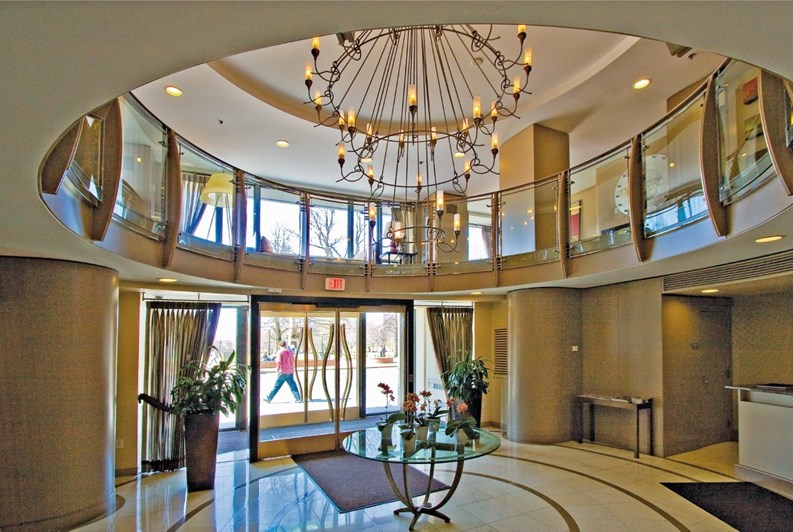Lobbies, corridors and common areas are the public face an HOA or condo community shows to the world. Shabby, threadbare, or painfully dated common areas can hurt overall property values and send the wrong message about how a community is maintained and cared for.
Of course, a newly-refurbished grand entrance and beautiful common areas that give owners bragging rights are universally popular, but when it comes to paying for that refurbished lobby, or stepping over painting or plastering crews' equipment, the consensus can sometimes break down. Some owners may want low-maintenance floor tiles in place of carpet that needs frequent shampooing, for example, while others insist that Persian area rugs are the way to go—and if the lobby and common areas aren’t too awful, there are always a handful of frugal owners who insist renovating can be put off entirely for at least another year or two.
So how does a condo community or HOA determine when its common areas are due for renovation, and how much renovation is in order? As with most such issues, there are several different answers.
Balancing Budget and Buy-In
Whatever the project, it’s up to the board members to make aesthetic and economic decisions while maintaining a balance of interests. Juggling these tasks is not easy, especially when faced with the diverse and often cross-generational interests of homeowners who may not be sold on the project’s value. Balancing residents' priorities and concerns is sometimes tough. One faction may want their building to look great no matter what it costs, while another faction stands firm, rejecting all but the barest minimum project proposals.
Getting skeptical residents to "buy into" a renovation or remodeling plan involves more than just putting a line or two about the proposed project into a newsletter or sticking a notice up on a cork board in the entryway. The most successful projects tend to be those where residents are involved early on in the process, and feel that their concerns and input are valued and taken seriously. Experts agree that communication is key to securing broad-based support amongst owners. Open meetings, and the creation of sub-committees where appropriate can help residents become more educated on the issues, and become more supportive of the board’s position on a project.
According to Peter Moran of management firm Marshall & Moran LLC in Morristown, one angle to take with residents is to remind them that fresh, appealing common spaces improve everyone's investment. "If things are looking worn-out," he says, "that affects the property values, and it's time think about updating."
Another approach is to present residents with a reserve study outlining timeframes, budgetary limitations, and schedules for future projects in black-and-white. "Reserve study reports are extremely helpful," says Moran, "because it allows an association to plan ahead financially for things like that."
How often or to what degree a condo or HOA undertakes a renovation of its common areas, "obviously is determined by the amount of money the condo has," says Moran. "Some condominiums never want to raise their maintenance fee, and they kind of pay the opposite way for that in the long run because they don't have the money to update things. They keep putting it off and putting it off, while other ones that keep their maintenance fees caught up with the cost of living can update things a lot quicker."
The process of devising the right design plan for a common area is partly about finding a happy medium that's palatable for most residents. Design questions are a matter of taste, so not everyone will agree on choices made in renovation projects, but consensus should always be the goal for boards and their design professionals. “When the board or property manager is looking for opinions, they should remember that common areas are not individual apartments,” says Sivan Mair, co-owner of Art & Interiors, an interior design firm in Woodbury, New York. “You want it to be comfortable for most people in the building.”
First Impressions
Refurbishing or remodeling a clubhouse or entry hall is a different proposition than replacing windows or some other large-scale capital improvement, says Moran. "On something like a roof replacement, you have an engineer who comes in and just tells you how it should be. In a condo community, if you want to change something about the appearance, you generally have to get a vote from the entire association."
Arriving at a consensus among residents—or even just the members of a design committee—can be a challenge, says Moran. But he adds that for the most part, a clean, neutral color palette and uncluttered floor plan in HOA common areas and hallways is the safest, most durable bet.
"Normally, it's best to go with a very basic, neutral color," says Moran. "Plain white, or a beige; something that is very clean. You want nice landscaping outdoors, but as far as building interiors go, you want to keep everything as simple as possible so that it doesn't look like you live in the '60s. A simple and clean-looking design looks good, brings out the landscaping, and doesn't interfere much with each person's personal taste."
Warren Heit, owner of Mt. Vernon, New York-based S & W Painting agrees, and adds that a successful common area has a pleasing color scheme—but it doesn't stop there. It also includes other elements of the room, such as moldings, window treatments, and furnishings. “The colors should be in sync with each other,” Heit says. “In a successful common area, all of the colors and motifs will blend together for a nice aesthetic finish.”
Like many designers, Heit recommends using earth tones in common spaces and hallways. For long hallways, he recommends cozy colors like cocoa and warm, olive greens. He advises boards and managers of buildings to hire an interior designer to help them with improvements to common areas. “A good designer will give you different ideas and options of what you can do,” Heit says.
Form Follows Function
Understanding that design selections for common areas should be consistent throughout a building or development from the lobby to corridors to community rooms, smart boards and design committees will focus on design requirements that fit the space, scale, and scope of the project.
That means considering design options that are compatible with the functional needs of the building, the budget, and the board’s vision. Simply put, if the lobby will become more than a space to pass through—inviting residents and visitors to congregate—adding comfortable chairs placed in an arrangement designed for that function is a good idea.
With a goal in place, a design professional works with the board regarding the condo’s design options, through space planning, product research, budget review, and specifications for purchase. An association's budgetary guidelines set out the parameters within which the designer will work; however, the board reserves the right to review and amend his or her recommendations.
Establishing goals helps to keep the project moving. The initial design phase is exploratory in nature, presenting many options. Product selections will be determined by functional requirements, finish intent, durability, daily maintenance, cost, and overall aesthetic quality. Wholesale pricing made available through the designer, and reduced prices for items purchased in larger quantities can help keep the project affordable.
With the right manufacturer, custom goods do not have to be cost-prohibitive. “Some mills offer low minimums for custom goods,” says Scott Johnson, a manufacturer’s representative for Fortune Carpet and Gerflor flooring. Johnson adds, “a few small mills have sample plants which can turn custom samples overnight to the client. You get more service, flexibility, creativity and quality from smaller manufacturers.”
Thoughtful planning can stretch budget dollars. One key idea suggested by the pros is breaking the project into phases, often stretching over a few years. Unless there is a true safety concern, most projects can be done in steps, rather than all in one fell swoop.
Another more budget-friendly approach is to add new fixtures, which can offer added benefits and value without necessitating a full-on renovation. Stone fireplaces with gas convenience, and freestanding heaters in outdoor common areas are two examples of retrofits that are currently popular. Natural stone surfaces are both desirable and high-performance surfacing materials—and are available in a variety of cost alternatives. When determining selections for purchase, design professionals stress that the goal should be the best overall value, which tends to be the lowest long-term costs, not the lowest initial cost.
Green is Good
Board members can pass on significant savings to the homeowners by using green fixtures that reduce utility costs year in and year out. Products designed to be green that don’t sacrifice performance include low-flow toilets and energy-efficient light fixtures. Many of these products are supported by incentives from local utilities. For specialty flooring, says one Massachusetts-based designer, “Clients often ask about products that are green, but are unwilling to pay for it. Take into consideration a product like vinyl flooring. The most important aspect is that by far, it has one of the longest life cycles of any product, which is the biggest environmental statement you can make.”
Other green products may not save energy, but are recognized for being safer for owners, or environmentally-friendly. These include contract carpeting recognized for its post-industrial recycled content; fabrics produced using rapidly renewable materials, and non-VOC paint, which has no lingering odor, is more durable, and dries faster.
And speaking of green, plants help create healthy environments as well, adding vitality to a space, and becoming important design elements in their own right. Through form and texture, they can fill empty spaces begging for attention. What plants are popular today? Alexia Morosco, the general manager of garden design for Winston Flowers in Boston, turns to varieties of floor plants that have exposed trunks and interesting leaf shapes. She explains, “Popular plant varieties include Yuccas, the Ponytail Palm, Pencil Cactus, and Jade trees. Plant varieties that are long lasting and are easy to care for under a broad range of conditions offer good value. Select good performers such as Philodendron Moonlight or the spiky Sansevieria Cylindrical.”
High-end condominium properties are increasingly using plants as a design element, often placing emphasis on the container. Morosco says, “Containers in various finishes such as metal, wood, and metallic glazes are all hot right now. Use groupings of pairs or collections of containers in a series of even numbers. By adding a combination of specimen plants and rock top dressings, containers allow you to bring organic elements indoors. Thoughtful placement of common varieties of plants in distinctive containers will help them appear fresh and new.”
When renovating common areas, an inspired approach to product selection, combined with thoughtful planning that focuses on practicality, will ensure success and create the broadest appeal. Well-designed common areas will be worthy of display, and unit owners will live in a condominium building that they are proud to call home.
Lisa Goodman is a freelance author and principal of Lisa Goodman Design in Sharon, Massachusetts. Additional research by David Chiu and Hannah Fons.





Comments
Leave a Comment